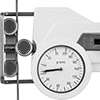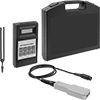Filter by
Capacity, English
Maximum Tension Force Rating
Measurement Unit
Weight Capacity
Capacity, Newtons
Accuracy, English
Weight Measuring Increments
DFARS Specialty Metals
Accuracy, Metric
Export Control Classification Number (ECCN)
Width
Depth
Housing Material
Component









































